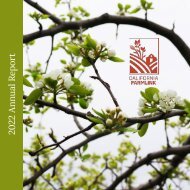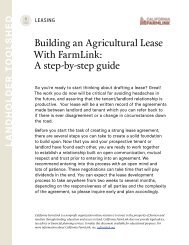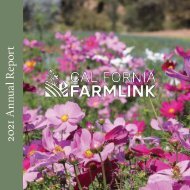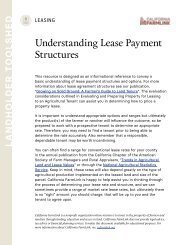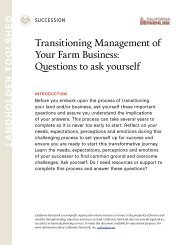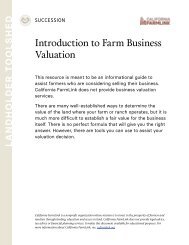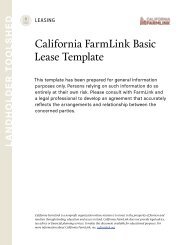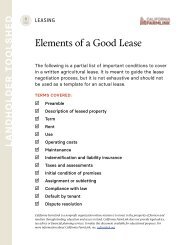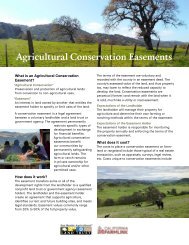Guide to Regenerative Grazing Leases: Opportunities for Resilience
California FarmLink and TomKat Ranch Educational Foundation teamed up to create this resource focused on land leases that support regenerative grazing practices. This guidebook aims to empower private, nonprofit, and public landholders, as well as easement-holders and grazing tenants.
California FarmLink and TomKat Ranch Educational Foundation teamed up to create this resource focused on land leases that support regenerative grazing practices. This guidebook aims to empower private, nonprofit, and public landholders, as well as easement-holders and grazing tenants.
You also want an ePaper? Increase the reach of your titles
YUMPU automatically turns print PDFs into web optimized ePapers that Google loves.
CHAPTER 3. Agricultural Management Plans (Continued)<br />
PRACTICE IMPLEMENTATION<br />
During the planning process, it is necessary <strong>to</strong> identify specific strategies or<br />
management actions that can be implemented <strong>to</strong> help achieve each SMART goal at<br />
the appropriate scale. In some cases, it may be desirable <strong>for</strong> the chosen strategies<br />
or actions <strong>to</strong> be supported by considerable anecdotal and scientific evidence,<br />
but some practices are intended <strong>to</strong> be more experimental, lending themselves<br />
<strong>to</strong> testing at small scales using the adaptive management framework. Chosen<br />
strategies or management actions can even be guided by principles. For example,<br />
stewardship of soil health can be guided by soil health principles, which include<br />
maximizing plant diversity, minimizing soil disturbance, extending the period of<br />
active plant growth if possible, and maintaining soil cover.<br />
There are many approaches and actions that can help achieve particular goals and<br />
SMART goals; it is beyond the scope of this guidebook <strong>to</strong> describe them all.<br />
Extending the above example of indica<strong>to</strong>rs and SMART goals <strong>for</strong><br />
four ecological outcomes.<br />
Here are four illustrations of management strategies or actions that might be used <strong>to</strong><br />
help achieve success:<br />
The first example SMART goal is <strong>to</strong> increase grassland<br />
breeding bird abundance <strong>to</strong> an average 4.25 birds per<br />
10 acres by a specific date.<br />
This type of numeric goal is best suited <strong>for</strong> longer-term (5-10+<br />
year) leases, and should consider fac<strong>to</strong>rs outside of the control<br />
of the grazier (<strong>for</strong> example, by comparing with overall bird population trends in the<br />
area). To achieve the bird number increase in this example, actionable strategies may<br />
include minimizing or eliminating grazing of high density grassland bird areas during<br />
the peak breeding season, or managing the grassland bird areas <strong>for</strong> short, perennial<br />
grass and few trees by carefully planned grazing of cattle and goats. For newer or<br />
shorter-term leases, it may be more appropriate <strong>to</strong> avoid species number targets,<br />
and focus on creation of the type and abundance of habitat that can be directly<br />
managed by the grazier.<br />
© Copyright 2022 Cali<strong>for</strong>nia FarmLink and TomKat Ranch Educational Foundation<br />
36



